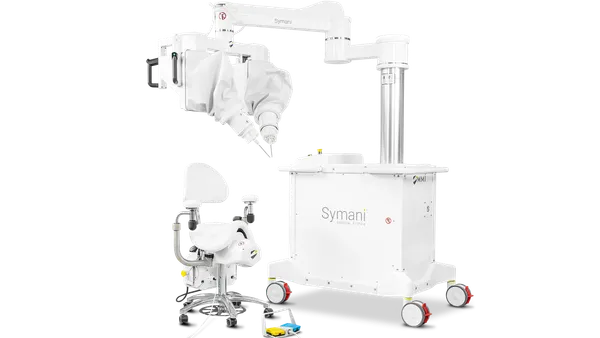Dive Brief:
- Edwards Lifesciences reported a 97% implant success rate in a 72-subject clinical trial of its tricuspid regurgitation (TR) device at the interventional cardiology meeting EuroPCR 2022. The results showed a reduction in tricuspid regurgitation, a condition where blood leaks between the two heart chambers because the valve between them doesn't close properly. Edwards' Pascal Ace device, intended to help this valve seal, is part of a segment that the company expects to nearly double in revenue between 2021 and 2022.
- Almost 80% of patients had implant success and at least a one-grade reduction in tricuspid regurgitation at discharge without surgical or percutaneous intervention or suffering any major adverse events over the 30 days after treatment, according to results presented at the conference. Two patients died after the procedure and three were re-hospitalized for heart failure.
- Abbott Laboratories arrived at EuroPCR 2022 with 30-day real-world data on its rival TriClip transcatheter valve repair system. Stifel analysts wrote in a Friday research note that their "initial reaction to the data was positive," noting a 98% implant success rate and 71% of patients with tricuspid regurgitation reduced to moderate or better levels. While Abbott's TriClip had a slightly higher implant success rate and a slightly lower rate of adverse events than Edwards' device, it's difficult to compare results between the two trials, given the differences in study sizes and patient severity.
Dive Insight:
Edwards is targeting sales of $140 million to $170 million from its transcatheter mitral and tricuspid therapies this year even as COVID-19 restricted use of Pascal in Europe early in the first quarter. The sales target is part of Edwards’ long-term goal of helping grow the market to $5 billion by 2028.
The forecast rests on upcoming data unlocking the U.S. market, as Edwards pursues approval for its Pascal device for patients with degenerative mitral regurgitation. The latest evidence comes from a 30-day readout from the TriCLASP study that is enrolling participants in Germany and Switzerland. At the same event, other researchers posted data from the first 300 patients in the TriClip bRIGHT study that is testing Abbott’s rival TriClip and TriClip G4 devices.
While confounding factors can render cross-trial comparisons unreliable, there are parts of the data that appear to favor Abbott’s device. The implant success rate was 98% in the Abbott study, compared to 97% in the Edwards trial. Abbott also reported an “acute procedural success” rate of 91%. The Edwards trial reported procedural and clinical success rates, both of which were 78%.
The proportion of patients with moderate tricuspid regurgitation at 30 days was 90% in the Edwards clinical trial, higher than the 71% in the Abbott study. The baseline characteristics were different as well. In the Abbott trial, 92% of participants had massive or torrential tricuspid regurgitation, the two most severe grades, compared to 15% of subjects in the Edwards study.
Baseline characteristics for the New York Heart Association (NYHA) Functional Classification were more closely aligned, with 77% of participants in the Edwards study and 79% of subjects in the trial falling into Class III or IV. NYHA Class III patients have marked limitations of physical activity, while Class IV patients are unable to carry out any physical activity without discomfort.
After 30 days, no recipients of Pascal were in Class IV and the proportion in Class III had shrunk to 44%. Some patients were in Class I after 30 days, whereas none were at baseline. Abbott’s device was unable to remove all patients from Class IV, with the proportion of participants in that category falling from 11% to 2% in the 30 days after treatment, although it had an effect on Class III. The proportion of people in Class III fell from 68% to 20%, resulting in 78% of patients being in Class I or II versus 56% in the Pascal trial.
The composite rate of major adverse events was lower in the Abbott trial, at 1%, than the Edwards study, at 3%, although Edwards' study included fewer patients than Abbott's.
Edwards had two of 67 participants report major adverse events after 30 days, such as cardiovascular mortality, stroke, new need for dialysis or renal replacement therapy and severe bleeding. Meanwhile, Abbott had three of 300 patients report major adverse events, including cardiovascular mortality, stroke, new onset renal failure and non-elective cardiovascular surgery.











